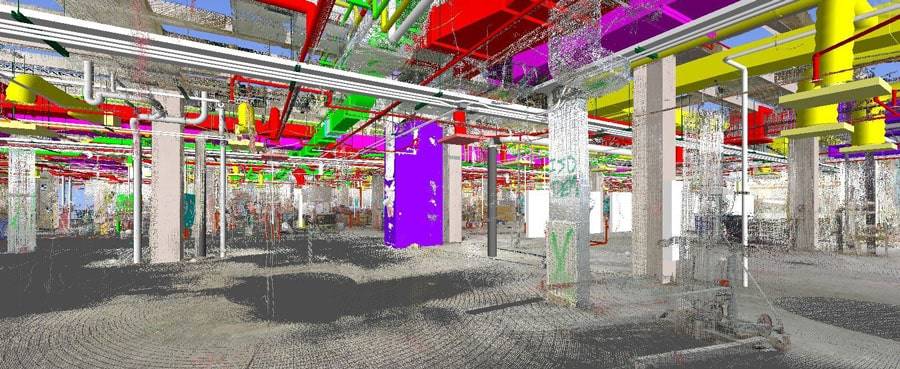Integrated Lean Project Delivery
To integrate new mechanical elements into existing conditions, the Mortenson team produced a 3D point cloud appended in Autodesk® Navisworks.
Project Challenge
Integrated Lean Project Delivery (ILPD) is a bold, calculated way to save project money, optimize results, reduce waste, and maximize efficiency throughout all design, fabrication, and construction phases.
A great example of that is a $200 million hospital modernization project. The project team, led by general contractor Mortenson Construction of Chicago, Ill., uses ILPD to bring the trades together as a single cohesive unit. It results in a more holistic, integrated way to build and becomes even more efficient if everyone accepts “one version of the truth” in project measurement.
Adding to the complexity: The hospital has no plans to close during the three-year modernization. Tim Schubert, Mortenson Integrated Construction Manager, and his team, along with a small subcontractor army, is required to stick the landing on a 2017 delivery while preserving hospital-grade noise and infection control. The pinpoint choreography has proven to be a case study in construction execution and timing.
Solution
To achieve that measurement precision, Mortenson relies on a FARO® Focus3D X 330 Laser Scanner.
The FARO Laser Scanner which is operated by Schubert and his team, produces a 3D point cloud of as-is conditions of any building environment. Their scans provide single-source accountability for all project measurements. The exceptional precision helps make the installation of pre-fabricated bathroom pods and MEP systems possible, wresting extra savings in cost and time from an intensely challenging facility makeover and expansion.
Key to that accountability is FARO SCENE Software which links CAD users and even non-CAD users to the scanned data, called a point cloud.
For users of CAD authoring applications like Autodesk® AutoCAD® or Revit®, FARO’s SCENE software makes integration with the point cloud easy. “When they’re drawing a pipe or ducts, they’re actually tracing the point cloud from SCENE Software,” Schubert explains.
CAD software integration is expected. What’s not expected—and this is “huge” Schubert emphasizes—is how a proprietary cloud-based hosting solution called SCENE WebShare Cloud empowers anyone with a browser to access the laser scan, no CAD software required. “That’s why FARO Software is awesome. Now anyone can take precise measurements from their browser.”
Net: No more back-and-forth with tape measures. “This is a sensitive healthcare environment,” Schubert cautions. “We can’t have people in here with muddy feet, sneezing or coughing, and risking injury in a busy, hazardous jobsite. WebShare Cloud makes the laser scans available to anyone, anywhere, anytime. There’s nothing like it.”
Results/Payback
Laser scanning also ends the finger-pointing, squabbling, and costly remediation that often results from traditional measuring. Schubert cites many examples, like concrete placement:
“We used the scan data on our slab-on-metal deck floors. We used a third-party software plug-in called Rithm to calculate floor flatness (FF) and floor levelness (FL). Rithm also allows us to do some beam camber and beam deflection work.
“We verified we were a little heavy on the concrete—the sleeves started disappearing. We were able to easily grind it down and stay within our tolerances.” The laser scanning helped them comply with the ASTM E1155-14 standards. What’s more, it only takes a few minutes for Schubert to confidently scan for FF/FL.
The dollar savings are substantial, too. “This is a very complex project with 21 phases. We paid our contractors $27,000 for pre-construction services for the initial phase, which meant we were looking at a bill for nearly $600,000 across all 21 phases.
Laser scanning cuts that to just $4,000 per phase. Scanning saves the owner nearly $500,000 on that alone,” Schubert reports.
Can Schubert imagine an ILPD project without laser scanning?
“No, this project would have been a complete disaster without it. Just to verify that, we tried to do an area without the scan. It was a complete mess. All of us vowed after that
we would not do another area without first scanning it.
“For many of our subcontractors, it was their first exposure to working from laser-scanned data. I think we made believers out of all of them,” Schubert states.
“This project is changing the way people think about the construction process.”
Produced by Hanley Wood Strategic Marketing Services Group I sms.hanleywood.com
